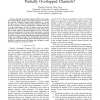Free Online Productivity Tools
i2Speak
i2Symbol
i2OCR
iTex2Img
iWeb2Print
iWeb2Shot
i2Type
iPdf2Split
iPdf2Merge
i2Bopomofo
i2Arabic
i2Style
i2Image
i2PDF
iLatex2Rtf
Sci2ools
WCNC
2008
IEEE
2008
IEEE
How Much Improvement Can We Get From Partially Overlapped Channels?
—Partially Overlapped Channel (POC) based design, has been identified recently as a promising technique to overcome the capacity bottleneck facing wireless engineers in various networks, such as WLAN, Wireless Mesh Network (WMN) and Ad Hoc networks. However, considerable confusions still exist as to the actual power of POCs to improve network capacity, especially since traditional communication system designs treat the so called Adjacent Channel Interference (ACI) as harmful. Based on measurements of actual testbed experiments, we model the impact of POCs on system design and use numerical method to analyze network capacity improvement comparing POC-based design and traditional design. Our investigation shows that for a wide class of network settings, POC-based design allows more flexibility in wireless resource allocation, and can improve overall network capacity by as much as 100%.
Network Capacity | Network Capacity Improvement | WCNC 2008 | Wireless Mesh Network | Wireless Networks |
| Added | 01 Jun 2010 |
| Updated | 01 Jun 2010 |
| Type | Conference |
| Year | 2008 |
| Where | WCNC |
| Authors | Zhenhua Feng, Yaling Yang |
Comments (0)

